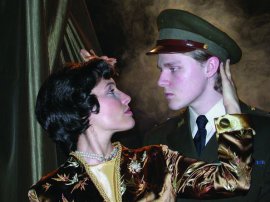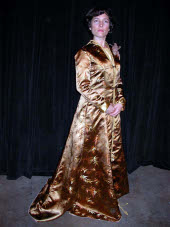 Before Friday night's presentation of Crème de Coco commenced, St. Ambrose University theatre professor Corinne Johnson briefly took the stage, and related how proud she was of the evening's entertainment - a world premiere by Broadway playwright William Luce, directed by Broadway veteran Philip William McKinley (both of whom were in attendance). As theatrical coups go, this one was way up there.
Before Friday night's presentation of Crème de Coco commenced, St. Ambrose University theatre professor Corinne Johnson briefly took the stage, and related how proud she was of the evening's entertainment - a world premiere by Broadway playwright William Luce, directed by Broadway veteran Philip William McKinley (both of whom were in attendance). As theatrical coups go, this one was way up there.
Yet as understandably proud as the school's staff was, it's inconceivable that they were any less proud of St. Ambrose alumna Kimberly Furness, who portrayed famed designer Coco Chanel in Luce's 80-minute one-act. For those in attendance for last weekend's shows, memories of Crème de Coco's grandeur will likely last several years. Memories of Furness' performance may last even longer.
During the actress' first 10 minutes, you may have thought you'd merely be treated to a first-rate comedic performance, as the show opens with the elderly Chanel railing against the bastardization of her life in the Broadway musical Coco. Furness physicalized Chanel's age beautifully (at the time of Coco's premiere, the designer would have been about 87), but even more impressive was the spectacular confidence with which she growled her wisecracks; Katherine Hepburn played Chanel on Broadway, and Furness made the utterance of the actress' name sound like the zenith in profanity. (Adding zing to these gags was Furness sounding just like Hepburn: "Life is a toboggan," she barked, approximating Hepburn's famous cadences. "I'm going to ride it 'til I die!")
And then the most extraordinary thing happened. Chanel began preparing for bed, yet with her right arm paralyzed following a recent stroke, it became clear that she couldn't do so without her maid's assistance, and Furness' expression while being slowly helped out of her jacket - annoyed, angry, and deeply embarrassed - was heartbreaking, as was her low, plaintive "Thank you" as Chanel's maid left the room. The moment was brief, and no big point was made of it, but in that instant you knew that neither the actress nor the playwright was going to be satisfied with a glib, jokey re-telling of Chanel's life story (though the script certainly isn't without its glib, jokey side).
 From that point on, Furness never left the stage, and never gave less than a magnificently focused, tough-minded performance; despite frequent flashbacks and personal reveries, her Coco Chanel didn't ever go soft. Luce's script found Chanel reminiscing about past lovers (including a young Nazi officer played by Jack C. Kloppenborg), interacting with long-departed friends, and withstanding the interrogations of a gruff French prefect (Andrew Harvey), and these sequences enabled Furness to reveal acute emotional shadings without abandoning her character's steely façade - in this larger-than-life role, the actress was masterfully subtle. (She was also masterfully funny; Furness earned a huge laugh with Chanel's succinct analysis of Jackson Pollock's works: "Wonderful paintings of ... paint.") I've enjoyed the splendidly gifted Furness in more than a dozen roles over the past 15 years, yet she was off-the-charts-good in Crème de Coco. And although the supporting actors oftentimes had only one major scene in which to make their marks, a number of performers came dangerously close to matching her.
From that point on, Furness never left the stage, and never gave less than a magnificently focused, tough-minded performance; despite frequent flashbacks and personal reveries, her Coco Chanel didn't ever go soft. Luce's script found Chanel reminiscing about past lovers (including a young Nazi officer played by Jack C. Kloppenborg), interacting with long-departed friends, and withstanding the interrogations of a gruff French prefect (Andrew Harvey), and these sequences enabled Furness to reveal acute emotional shadings without abandoning her character's steely façade - in this larger-than-life role, the actress was masterfully subtle. (She was also masterfully funny; Furness earned a huge laugh with Chanel's succinct analysis of Jackson Pollock's works: "Wonderful paintings of ... paint.") I've enjoyed the splendidly gifted Furness in more than a dozen roles over the past 15 years, yet she was off-the-charts-good in Crème de Coco. And although the supporting actors oftentimes had only one major scene in which to make their marks, a number of performers came dangerously close to matching her.
Kloppenborg's character was basically there to impart exposition about Chanel's Nazi affiliations, yet, to the actor's great credit, he also did so much more; Kloppenborg's naturalism and effortless charisma made you understand Chanel's fascination with this officer in ways the dialogue didn't. Meanwhile, Harvey made clear that his prefect wouldn't be intimidated by Chanel's imperiousness, and that he, himself, wouldn't be intimidated by Furness as an actor - the duo's badinage was filled with thrilling hostility. (Crème de Coco's most superb dramatic moment happened in silence, when the prefect stared Chanel down while she nervously drank a glass of water.)
Jamie Em Johnson was hysterically severe as an abbess from Chanel's youth, desperate to expose her former charge as untrustworthy; Johnson's and Furness' mutual loathing was a vicious kick. And as Chanel's confidante, Misia, Colleen Winters gave a buoyant impersonation of a dim bulb; this wannabe starlet seemed to exist in a loopy, fizzy reality all her own.
The production, though, was filled with truly admirable character work: Jeff De Leon, iconically assured as the love of Chanel's life; Jessica Denney, harrowing as an accused Nazi sympathizer who meets a violent end; Sean Tweedale, whose Jean Cocteau matched Chanel bitch for bitch. McKinley, it was clear, loves actors - you could practically feel the delight he took in letting them own the stage - and they responded to his generosity with panache; even the most minor roles here didn't feel minor. (We're only given one scene that shows Chanel-the-designer at work, but Marianna Caldwell - as a haughty Chanel customer - reacted to a new hat with such glorious comedic fulfillment that her expression said all we needed to know about the designer's talents.)
 As McKinley and Luce made clear during Friday's post-show Q&A, they still consider Crème de Coco a work-in-progress, and the production wasn't without its bumpy patches. I could never, for instance, quite figure out the logic behind the memory-play structure. Chanel's first reverie (with her Nazi lover) appears to come in a dream, but afterwards there's a blackout and an extended scene change, at which point we find ourselves in the prefect's office, which leads to another set of flashbacks - exactly where (and when) are we, anyway?
As McKinley and Luce made clear during Friday's post-show Q&A, they still consider Crème de Coco a work-in-progress, and the production wasn't without its bumpy patches. I could never, for instance, quite figure out the logic behind the memory-play structure. Chanel's first reverie (with her Nazi lover) appears to come in a dream, but afterwards there's a blackout and an extended scene change, at which point we find ourselves in the prefect's office, which leads to another set of flashbacks - exactly where (and when) are we, anyway?
Similarly, the play's breaking of the fourth wall was rather confusing, mostly because it felt so inconsistent; Chanel occasionally speaks directly to the audience, which makes sense, but so do a lot of the play's characters. (It's one thing for memory figures such as the abbess and De Leon's Arthur Capel to reference us directly, but why wouldn't Kloppenborg's Nazi do the same? And why does the "real-life" figure of the prefect deliver asides to the audience?) The internals of Crème de Coco's fantasy elements don't seem fully figured out yet.
Yet heaven knows the production didn't look like a work-in-progress. Dianne Dye's costumes were extraordinarily fine, and Kristofer Eitrheim's set design was like a costume in itself; with its ravishing golds and fuchsias and blacks, beautifully accentuated by Brad Frazee's gorgeous lighting effects, watching Crème de Coco often felt like falling into a designer gown. And McKinley lent the proceedings a graceful, understated elegance that perfectly matched its design and the frequent wit of Luce's script, which found the audience alternately laughing at the clever verbiage and hushed at the unexpected dramatic heft.
And, of course, there were the actors, led by the divine Kimberly Furness. Over the course of their Broadway careers, Luce and McKinley have been at least partially responsible for three Tony-winning performances thus far. Had Crème de Coco debuted at the Walter Kerr Theatre instead of the Galvin Fine Arts Center - and had Furness been there to debut with it - they might easily have upped that tally to four.








